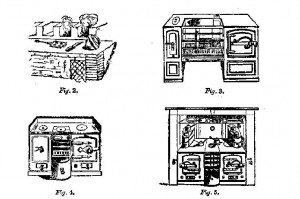Victorian Home: Kitchen (Part 4)
Posted By Brian Tomlin on May 20, 2013
Kitchens in the Civil War era were largely utilitarian, serving as the workhorse of most households. Meals were prepared, laundry was done, and activities as diverse as candle making, soap making, silver polishing, medical treatments, and in some cases things like bathing were all done in this room. As such, it was often the room most neglected in terms of decor or aesthetics.
The era of the 1860s was by and large much plainer and simpler than what we commonly think of as Victorian. But even so, homes of the era showed much greater contrasts with each other than we see today. The social and economic status of families as well as location (urban or rural) made large differences in available technologies, equipment, and help. Some kitchens had changed little since the colonial era, with cooking done in large fireplaces over open flames. Many families had newer wood or coal-powered stoves that cooked and heated the room.
In many areas how kitchens were used was seasonal in nature. In hot summers much of the cooking would be done outside in the open air or in a specially built building often called a summer house or summer kitchen. This kept the heat of cooking and laundry out of the main house, since there was no way to cool down a house once it got hot on a summer’s day.
Walls. Early-Victorian kitchen had very plain walls, usually painted in light shades of white, cream or tan. Woodwork in the room was painted a darker shade of the same color as the walls. The painted surfaces were easier to keep clean than wallpaper or stained woodwork.
Flooring. Kitchen floors were either wood (and usually a softer, less expensive wood than the rest of the house, like pine). The floors were often painted, and would be painted a more lively shade than the wall (greens, reds, mustards, grays). Oilcloths were frequently placed over the wood floor to protect them; these were heavy canvas or other heavy cloths that could themselves be painted and varnished and pasted to the floor.
Ceilings. Kitchen ceilings were almost always white during the 1860s, despite the other rooms in the house typically being painted in a lighter shade of the wall color. Pressed tin ceilings were found in wealthier homes as they were easier to clean.
Windows. More often than not kitchen windows would be left bare, but if they did have curtains, they were almost certainly simple fabrics.
Lighting. Candles, firelight, oil lamps and light coming through the window were the most likely light in a kitchen.
Furniture. The built-in kitchen with its set of cabinets and counter tops did not exist; when you moved into your home, often the kitchen was an empty room

Mrs. Beeton provided 1860s homemakers a sampling of the type of cooking equipment available to them.
with a large fireplace. You might be lucky and find a cast iron range or stove. You had to go out and purchase a variety of freestanding cabinets, work tables and other furniture to fill out your needs. You would have open shelves built on the wall, plate rails or hooks for dishes and pots and pans. Most homes had some kind of pantry lined with shelving for food staples, cooking equipment and other items stored in the kitchen. Since plumbing was not found in most homes of the 1860s, you would purchase a dry sink, so you could handle and store the water being brought into the house and have a place to perform some of the messier kitchen tasks. Frequently a low cabinet/table was placed near the back door and called a water table, where you would place the large bucket of water brought in from the well or cistern outside. This had a dipper to get water for drinking and any other household use. Other specialized furniture pieces were pie safes, jelly cupboards, and if you were lucky, a large oak ice box for storing ice.
Equipment. Mrs. Beeton’s Book of Household management provided a contemporary list of items you needed to start your kitchen.
- 1 tea-kettle
- 1 toasting fork
- 1 bread grater
- 1 pair brass candlesticks
- 1 teapot and tray
- 1 bottle-jack
- 6 spoons
- 2 candlesticks
- 1 candle box
- 6 knives and forks
- 2 sets of skewers
- 1 meat chopper
- 1 cinder sifter
- 1 coffee pot
- 1 colander
- 3 block-tin saucepans
- 5 iron saucepans
- 1 ditto and steamer
- 1 large boiling pot
- 4 iron stew pans
- 1 dripping pan and stand
- 1 dustpan
- 1 fish and egg slicer
- 2 fish kettles
- 1 flour box
- 3 flat irons
- 2 frying pans
- 1 gridiron
- 1 mustard pot
- 1 salt-cellar
- 1 pepper-box
- 1 pair of bellows
- 3 jelly molds
- 1 plate basket
- 1 cheese toaster
- 1 coal shovel
- 1 wood meat-screen
 ;
;


Thank you for this information. It will be very helpful to me in researching my program that I do on the Southern Homefront during the war.
I’m really glad I found this info. I’m building a Victorian dollhouse and I didn’t really know what belonged in a kitchen if that era. Thanks!
Sounds fascinating, I would like to see what it looks like when you are finished.